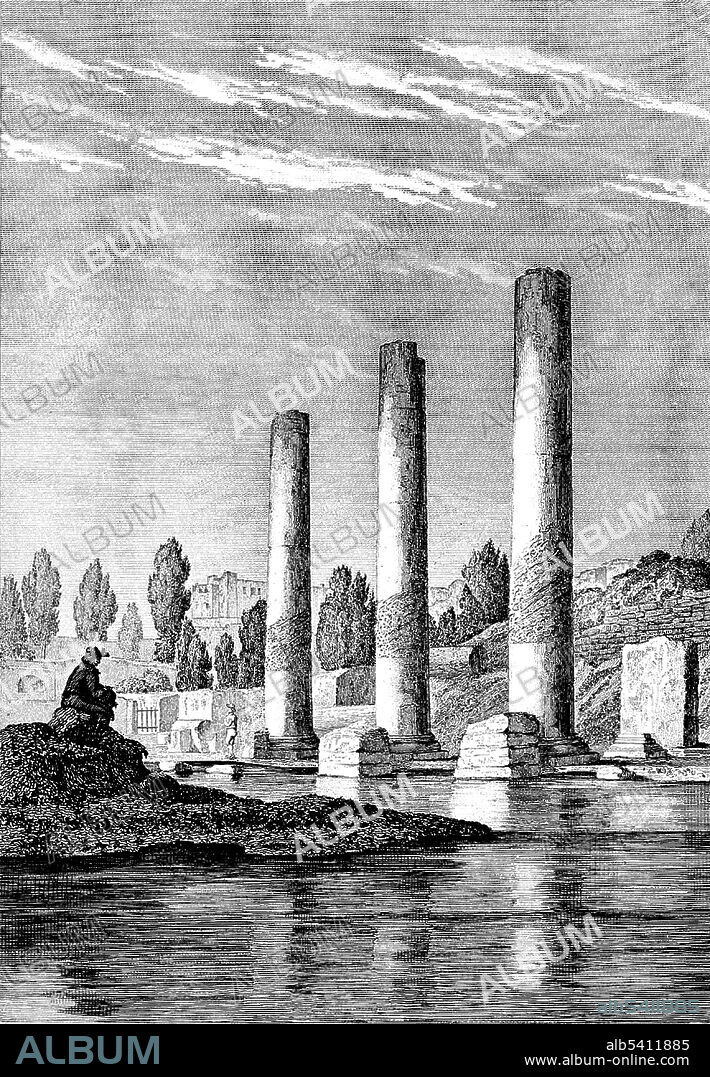alb5411885
Temple of Jupiter Serapis,1830

|
Add to another lightbox |
|
Add to another lightbox |



Buy this image.
Select the use:

Title:
Temple of Jupiter Serapis,1830
Caption:
The Temple of Jupiter Serapis at Puzzuoli, Naples, Italy. This Roman temple was partially submerged after construction, and was subsequently uplifted. The roughened area in the middle of each column shows the effect of marine rock-boring clams (Lithodomus); the dividing line and the smooth area at the bottom of each column shows how far it was buried in sediment, thus avoiding the clams. Charles Lyell used this image as the frontispiece from Principles of Geology Vol. 1, 1830 to demonstrate that ongoing geological processes can have significant effects over long period of time. Charles Lyell (November 14, 1797 - February 22, 1875) was a Scottish geologist. Lyell at first embarked on a legal career, but his interests in geology led to his appointment as secretary of the Geological Society in 1823. In 1830-33 he published his three-volume masterpiece, Principles of Geology. In it, he provided proof to support the principle of Uniformitarianism stated by James Hutton. This principle stated that rocks and geological formations are the result of ordinary slow processes such as erosion and not a past catastrophe. A friend of Darwin, Lyell wrote The Antiquity of Man (1863), but himself denied that evolution could be applied to humans. He was knighted in 1848. He died in 1875, at the age of 77, as he was revising the twelfth edition of Principles. He is buried in Westminster Abbey.
Credit:
Album / Science Source
Releases:
Model: No - Property: No
Rights questions?
Rights questions?
Image size:
3119 x 4500 px | 40.2 MB
Print size:
26.4 x 38.1 cm | 10.4 x 15.0 in (300 dpi)
Keywords:
1830 • 1830S • 19TH CENTURY • ANCIENT CIVILIZATION • ANCIENT • ART • ATTORNEY • BW • CELEBRITIES • CELEBRITY • CHARLES LYELL • CLASSICAL • ENGLISH • FAMOUS PEOPLE • FAMOUS • FRONTISPIECE • GEOLOGIA • GEOLOGICAL FEATURE • GEOLOGIST • GEOLOGY • HISTORY • ITALIA • ITALY • LAWYER • LYELL • MONUMENT • NAPLES • PRINCIPLES OF GEOLOGY • PUZZUOLI • ROMAN EMPIRE • ROMAN • RUIN • RUINS • SANCTUARY • SCOTTISH • SIEGE • SIR • SITE • TEMPLE OF JUPITER SERAPIS • TEMPLE OF JUPITER • TEMPLE • UNIFORMITARIANISM
 Pinterest
Pinterest Twitter
Twitter Facebook
Facebook Copy link
Copy link Email
Email
